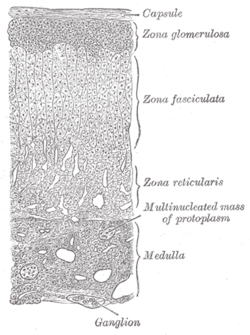Chromaffin cell
| Medullary chromaffin cell | |
|---|---|
 Adrenal gland. (Medulla labeled at bottom right.) | |
| Details | |
| Location | Medulla adrenal gland |
| Identifiers | |
| Latin | endocrinocytus medullaris |
| MeSH | D019439 |
| TH | H3.08.02.6.00015 |
| FMA | 69263 |
| Anatomical terms of microanatomy | |
Chromaffin cells, also called pheochromocytes (or phaeochromocytes), are
Structure
There are two types of cells that originate from the neural crest and are related to the sympathetic nervous system (originate from a cell called sympathogonia):[2]
1) Neuroblasts: These cells migrate, during the fourth to the fifth week of fetal development in humans, on both sides of the spinal cord toward the region just behind the dorsal aorta forming the two chains of sympathetic ganglia (Sympathetic chain). From these ganglia, the post synaptic sympathetic fibers will arise and extend toward their target organ. Some of these cells will migrate to the adrenal medulla to form sympathetic ganglia cells within the adrenal medulla (without postsynaptic sympathetic fibers). A tumor arising from these cells is called neuroblastoma.[3]
2) Chromaffin cells (or pheochromocytes): These cells will migrate to the area adjacent to the sympathetic ganglia (hence the name paraganglia) and to the adrenal medulla where they will be the most abundant type of cells. The largest extra-adrenal cluster of chromaffin cells in mammals is the organ of Zuckerkandl.[4] Tumors arising from these cell are called paragangliomas or pheochromocytomas. These terms can be used interchangeably but usually paraganglioma refer to a tumor originating from chromaffin cells outside the adrenal gland, which can also be called extra-adrenal pheochromocytoma, whereas pheochromocytoma typically refer to a tumor originating from the chromaffin cells within the adrenal gland.[2]
Chromaffin cells also settle near the
In non-mammals, chromaffin cells are found in a variety of places, generally not organised as an individual organ, and may be without innervation, relying only on
Function

Chromaffin cells of the adrenal medulla are innervated by the

Clinical significance
Neoplasms arising from these cells are pheochromocytomas (also called chromaffin or sympathetic paragangliomas, in contrast to non-chromaffin or parasympathetic paragangliomas of glomus cells). Sometimes only neoplasms of adrenal origin are named pheochromocytomas, while others are named extra-adrenal paragangliomas.
Heart failure
Following
History
The word "chromaffin" comes from a portmanteau of chromium and affinity. They are named as such because they can be visualised by
The
See also
- List of distinct cell types in the adult human body
- List of human cell types derived from the germ layers
References
- PMID 23078542.
- ^ a b "Chapter 179. The Paraganglionic System: The Paraganglia - Review of Medical Embryology Book - LifeMap Discovery". discovery.lifemapsc.com. Archived from the original on 2016-12-20. Retrieved 2017-06-03.
- ^ "Chapter 164. The Autonomic Nervous System: The Sympathetic System - Review of Medical Embryology Book - LifeMap Discovery". discovery.lifemapsc.com. Archived from the original on 2017-05-05. Retrieved 2017-06-03.
- PMID 23078542.
- S2CID 42402600.
- PMID 4941407. Archived from the original(PDF) on 2016-03-05. Retrieved 2013-03-01.
- PMID 11315316. Archived from the original(PDF) on 2017-08-09. Retrieved 2013-02-25.
- ISBN 978-0-443-06850-8.
- PMID 26849467.
- PMID 20351116.
External links
- Histology image: 14507loa – Histology Learning System at Boston University - "Endocrine System: adrenal gland, reticularis and medulla"
- Secretion Control in Adrenal Chromaffin Cells
- UC-San Diego Chromaffin Cell and Hypertension Research
- A Primer on Chromaffin Cells
- Rat Chromaffin cells primary cultures: Standardization and quality assessment for single-cell assays (a protocol)
- [https://pscientifics.com/adrenal-chromaffin-cell-stain-giemsa-staining-method/Adrenal Chromaffin Cell Stain (Giemsa Staining Method)
]
